Page 14
19 Jan 2012
[Embedded Adventures now has the MCP2210 available as a module]
As the USB serial interface protocol has become more and more standardized for serialcommunication between electronic devices, it would be helpful to find a solution that wouldintegrate USB on circuits that only use the SPI protocol. Microchip has just announced a new plug-and-play solution, which is the new HID-class MCP2210 USB to SPI protocol converter. This device makes it fast and simple to add USB to SPI-based designs for serial data transfer and analysis, and many other USB functions.
The MCP2210 USB to SPI protocol converter utilizes the USB HID class, which is supported bythe Windows XP, Vista, 7, Linux and Mac OS operating systems. Designs can be further simplifiedby nine flexible, general-purpose I/O pins that can be configured with a PC as standard digital I/O pins or alternate configurations. This adds enough flexibility to support a wide range ofapplications.
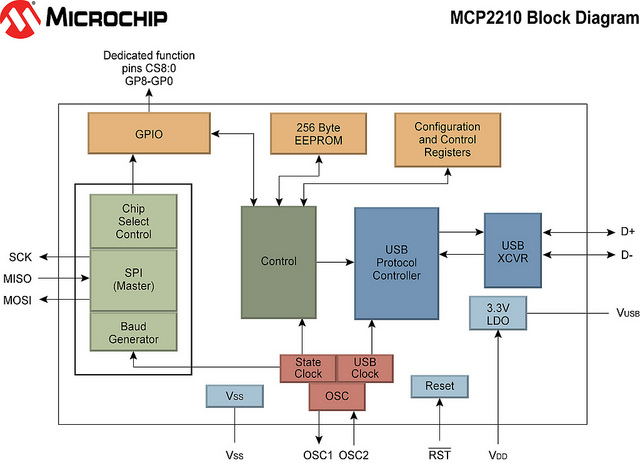
Designers without expertise in USB can use Microchip's MCP2210 Evaluation Kit (part #ADM00421) which makes it quick and easy to add USB connectivity into their projects. Free downloads are provided for software drivers, DLLs and a PC configuration tool. There is also a utility for MCP2210 power-up configuration.
The MCP2210 supports all four SPI modes (0, 1, 2, and 3) with bit rates from 1500 bps upto 12 Mbps. The device can operate from 3.3V to 5.5V at a temperature range of -40C to +85C. This chip is probably the most cost-effective and smallest footprint option for adding USB connectivity to SPI-based systems. The Microchip MCP2210 is available in a 20-pin SSOPpackage and a 20-pin 5×5 mm QFN package.
Microchip has recently expanded the PIC10F, PIC12F and PIC16F families by introducing several new 8-bit PIC microcontrollers featuring configurable logic and a high level of peripheral integration in 6- to 20-pin packages. The PIC10F(LF)32X and PIC1XF(LF)150X MCUs integrate new peripherals, including configurable logic cells (CLCs), complementary waveform generators (CWGs) and numerically controlled oscillators (NCOs). With the enhanced functionality and such a low pin count, embedded designers and engineers can greatly simplify their designs with a much lower part count, size, cost, and power consumption.
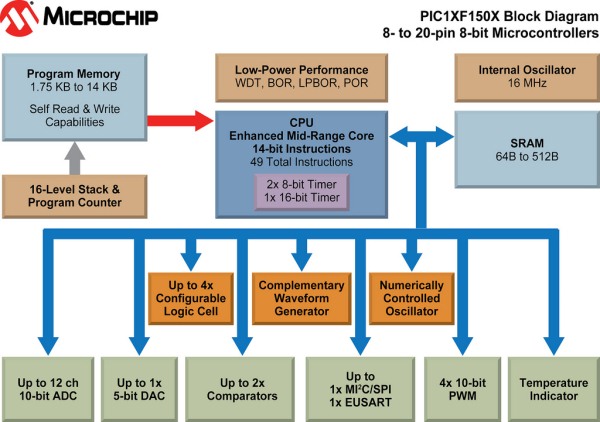
Engineers would be able to create many new applications and provide enhancement to many applications that already exist in the automotive, consumer, appliance, and industrial markets, among others. Software code can be used to control the combinational and sequential logic on the CLCs for on-chip interconnection of peripherals and I/Os. This adds improved functionality while reducing external component count and code space needed for the new functions. The CWG works with peripherals to generate complementary waveforms with dead-band control and auto shutdown for improved switching efficiencies. The NCO peripheral features linear frequency control with high resolution for applications such as lighting ballast, tone generation, and other resonant control circuits.
The PIC10F(LF)32X and PIC1XF(LF)150X MCUs operate at less than 30 μA/MHz in active mode and less than 20 nA in the sleep mode, and feature an analog to digital converter, up to 4 10-bit Pulse Width Modulation peripherals, and an integrated temperature-indicator module which enables low-cost temperature measurements. For programming, these MCUs have 35 instructions, 8 Stack Levels, 1.75K to 14K of Flash memory, and 64 to 512 bytes of RAM.
These MCUs are supported by Microchip's standard development tools, including the PICkit™ 3 Debugger/Programmer, as well as the MPLAB® IDE, MPLAB REAL ICE™ In-Circuit Emulator and MPLAB ICD3 In-Circuit Debugger, and the Microchip and HI-TECH C compilers. The PICDEM Lab Development Kit and the F1 Evaluation Platform has also been introduced for developing this series of 8-bit PIC MCUs. Programming the configurable logic cells (CLCs) has also been greatly simplified with a free CLC Configuration Tool, which can simulate the functionality of the registers and combinational logic with a graphical user interface.
10 Jan 2012
Microchip has just announced the latest addition to its eXtreme Low Power (XLP) microcontroller family with the PIC24F "GA3" series. The new PIC24FJ128GA310 family has the lowest active current available for 16-bit Flash MCUs and offers several flexible new low-power sleep modes. The active current is rated at 150 microamperes/MHz, and the current for a new low-power sleep mode with RAM retention is 330 nA. With the new idle and sleep modes, clock speeds can be reduced on the fly and peripherals can be selectively shut down for significant power reduction.
These devices are the first PIC MCUs with battery backup of the On-Chip Real-Time Clock Calendar, which allows an application's Real-Time Clock to continue running when primary power is removed. A VBAT pin is used to supply power for this and draws only 400 nA. They are also the first MCUs that are able to directly drive LCDs in low power sleep mode (up to 480 LCD Segments or 60 segments by 8 common lines) which can work with more informative and flexible displays that include descriptive icons and scrolling. A six-channel DMA supports all types of peripheral modules.
Along with several enhanced peripheral features, the device includes many useful analog features such as a 10/12-Bit, 24-Channel Analog-to-Digital (A/D) Converter where conversion can be done in idle mode, an on-chip programmable voltage reference, a Charge Time Measurement Unit (CTMU) which is used for capacitive touch sensing for up to 24 channels, and CTMU temperature sensing. 12-bit ADC features works in conjunction with the CTMU to further reduce power consumption by performing proximity sensing while in sleep mode.
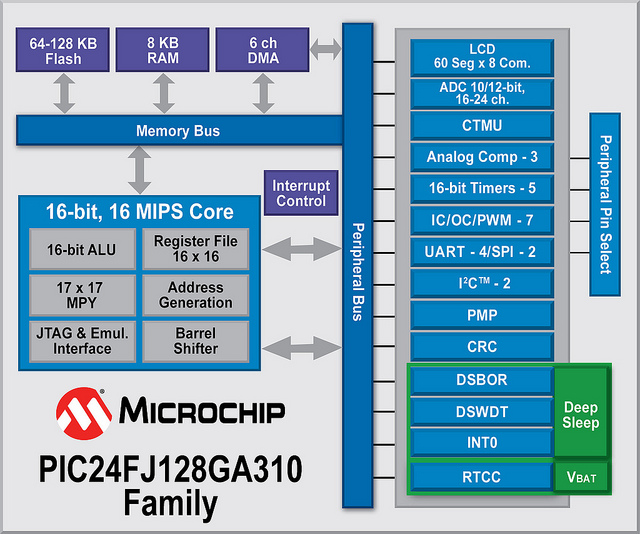
The PIC24F GA3 devices have the potential to provide more efficient, less expensive designs for consumer, industrial, medical, metering, and other types of applications. Microchip also offers the PIC24FJ128GA310 Plug-In Module for use with the Explorer 16 Development Board with a built-in 480-segment LCD display for customers who would like to evaluate or develop designs for customized applications.
6 Jan 2012
The new Arduino Wifi Shield from async_labs can become a new standard in bridging the gap between serial ports and wireless communications in embedded systems. It can transfer data to or from an Arduino board with an SPI interface at speeds up to 25MHz. The Arduino WiFi shield then provides 802.11b connectivity for wireless communication between an Arduino board and the Internet.
The Arduino WiFi shield is an add-on board based on the ZeroG WiFi module, which is a Wifi micro module made by H&D Wireless. This add-on board offers huge advantages over existing Wifi shields in that it has its own processor (AVR32), and it has the full TCP-IP stack which allows it to become completely hackable for use with customized protocols or other system requirements.
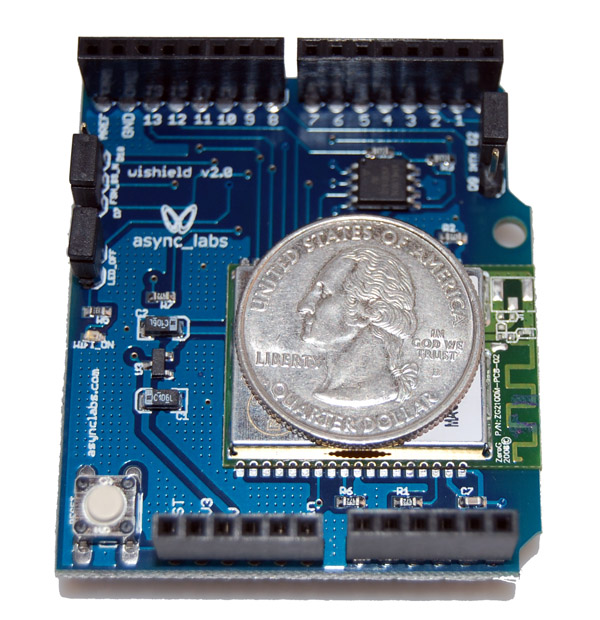
This device is capable of setting up its own network and/or connecting to other wireless networks. There is software available which enables a WiShield-equipped Arduino to act as a web server and a web client concurrently. This is the WiServer code, which is an easy-to-use HTTP library designed for use with the WiShield. It can use various encryption protocols, such as WEP and WPA/WPA2.
The Arduino WiFi shield is compatible with thenew Arduino 1.0 software, and it is also possible to migrate code from the Ethernet Shield with minor changes. The power needed for the shield is 165mA while transmitting and 85mA while receiving.
3 Jan 11
For most embedded electronics projects, the lowest cost and most effective method would be to use microcontroller development boards. But in some applications, such as video processing, speech synthesis and recognition, and other high-volume, high-speed data processing applications, it would be worthwhile to consider a FPGA (Field Programmable Gate Array) solution. Instead of using a software development tool to code sequential instructions, FPGA’s have a hardware development tool to code digital logic circuits to perform a specific function. This would enable the device to operate much faster than by using coded instructions. FPGA’s usually have a lot of I/O pins compared to an MCU so they are able to handle large amounts of data in parallel.
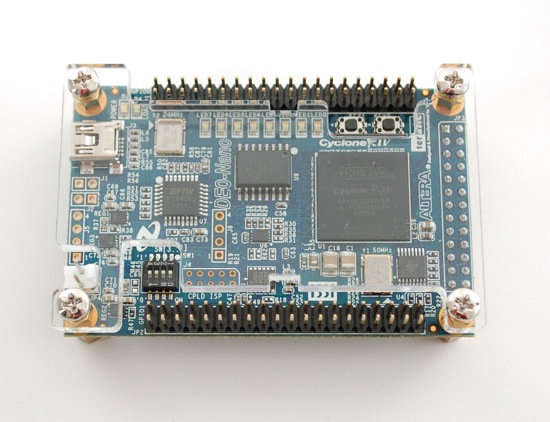
An ideal choice for starting out would be the DE0-Nano – Altera Cyclone IV FPGA starter board. This development board is designed for beginners and has a built-in USB ‘blaster’ programming interface for FPGA configuration. Two CDs are supplied along with the software necessary to ‘compile’ and ‘upload’ code into the board. The software is available for Windows and Linux computers.
The DE0-Nano has a total of 153 I/O pins a collection of interfaces including two external GPIO headers to extend designs beyond the basic DE0-Nano board, On-board memory is included, with 32 MB of SDRAM and 2 Kb of EEPROM for data storage and frame buffering, as well as a few useful switches, LEDs, and push-buttons.
The Altera Cyclone IV 4C22 FPGA used on the board contains several useful features. Some of these include 22,320 Logic elements, 66 Embedded 18 x 18 multipliers, 4 General-purpose PLLs, a 3-axis accelerometer, and an 8 channel A/D converter. The board uses very little power and small batteries can be used in portable mobile applications, or it can be powered through a USB cable.
1 Jan 11
From all of us at at Embedded Adventures, we want to wish you a a fantastic 2012. It's an exciting time in embedded electronics - never before has so much computing power been available at so little cost, in such small packages. And with more things to connect to all this computing power, from LED alphanumeric displays to air pressure sensors and beyond, the scope for turning your idea into reality has never been greater.
We love experimenting with new ideas and new products, so please keep the emails coming. If you come up with a great idea and we end up making it en masse, our tradition is that we send you one free of charge. So keep your ideas coming to ideas@embeddedadventures.com!
And please let us know any other feedback you have as well - recently we had Embedded Adventure Greg suggest that an RSS feed would be handy for keeping up with news articles on the site. Great idea! So we're going to do that shortly.
Thanks for sharing your adventure with us and we look forward to spending 2012 with you.
With best wishes,
All the staff at Embedded Adventures.
